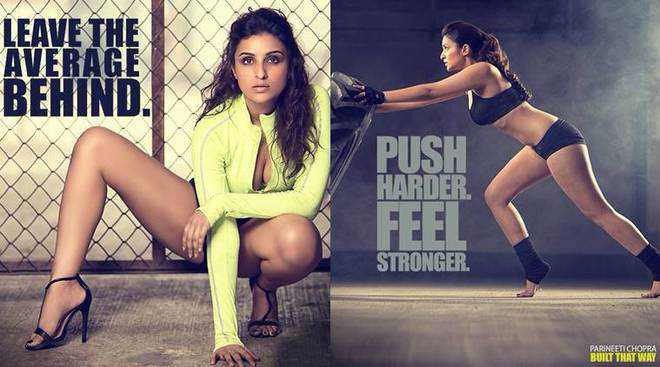Aastha Kalia
Last year, actress Parineeti Chopra had a huge surprise for her fans. The Meri Pyari Bindu star impressed the world as she released a series of photographs showing her body transformation. The actress looked fitter; she had lost about 10 kgs. Not long after, high drama unfolded on Twitter, where a video of Parineeti wishing a friend happy birthday was posted. When asked what tips she would like to give to her friend, she advised, “Eat less and become thin.” This threw Twitterati into a rage. They blamed the actress for fat shaming her friend. Twitter seemed extra tough on the actress, who had, in the past, had to go through body shaming herself. The video was soon deleted.
Thankfully, for most of us, a new era of body-type acceptance seems to have begun. Maybe it’s just another marketing hack by companies vying to make both profits and headlines. However, it has helped women across the world celebrate realistic body images. The “Real Beauty” campaign by Dove showcases women of different body types and skin colours stripped down to their undergarments in a single frame. Their dazzling smiles speak volumes and challenge the quintessential tall and slender image of a model. With big international brands like Ole Navy, Lulu Lemon and H&M backing body diversity, the scene seems to be changing gradually. American Eagle and Melville were huge ambassadors for the “One size fits all” clothing line.
However, at times, marketing madness takes over and companies take things a bit too far. This one involves Dove too. The brand recently came under fire when it released a product line featuring six bottles in various shapes; the motto being: beauty comes in all forms. This bleak objectification of a woman’s body shape made them the new junction of trolls and memes. People posted pictures of bottles that they thought resembled the product line. In fact, the concept of “one size fits all garments”, too, has been receiving a major backlash. We all know that all women can’t fit into a garment of the same size!
Jacqualine Kiara Ledlie, a plus-size model and reality TV star who featured in an MTV show, blames it on the lack of information among people. “An education on different body types is essential. Even with proper diet and exercise, everyone is bound to look different. Just because someone is heavier than typical standards doesn’t mean one is unhealthy. Or if someone is thinner, not necessarily is he suffering from an eating disorder.”
Psychologist Nikita Virlley says the society has stereotyped ideas of beauty and cultural importance is given to certain body types. “A point that everyone keeps missing is that it is not about being thin or fat, but healthy physically, as well as mentally. The key to self-acceptance is to follow a middle path that is accepting your body the way it is. Besides, one must work on it to become healthier,” she adds.
Still, as more of positive stories flow in, hearts feel overwhelmed. Like in times when South Asians are racially profiled, a new face of positive imaging has come up. Companies are not just bringing body weight and colour into the “larger realm’, but ethnicities also. In H&M’s recent “Close The Loop” campaign, which ran at Times Square in New York, 11 Sikh men were part of the video. A Muslim woman wearing a hijab featured too. A mega sports brand released a range of hijabs for Muslim women who have being struggling with their clothing while playing sports.
All small changes, yet these go on to reinforce that body shaming is wrong and unjustified. In the real world, it’s tough to match up to the unrealistic expectations set by Victoria’s Secret’s models or a Bollywood actor with six-pack abs. The only doable thing is to accept your look and love what you see in the mirror every morning.
Fighting it out
International pop star Demi Lavto has been very vocal about her struggles with body issues. Her nude photo shoot for Vanity Fair was Photoshop- and makeup-free and aimed at making a strong statement about being comfortable in her own skin. Comedian Amy Schumer has also bared down for numerous magazine covers. Bollywood actress Vidya Balan has openly spoken about how she had a hard time accepting her body because of regular criticism from the media. Huma Qureshi (below) and Sonakshi Sinha have been active in discouraging the online bullies targeting them for their weight and size.
As I like it
Last year, the audience at Marianna Harutunian Royal Fashion Day in London were in for a surprise when they saw Harnaam Kaur (below) opening the show. Her walk broke many a stereotypes. Not only was she supporting a full-bearded look, she was also wearing a dark blue turban which roots back to her Sikh background. The 25-year-old suffers from a condition called Polycystic Ovary Syndrome, a hormonal issue that causes excessive facial hair growth. Bullied all through her teenage life, she had spent thousands of pounds to maintain a typical feminine hairless face, which meant sometimes getting waxed thrice in one week. It was only after being ridiculed recklessly that she decided to accept her condition and flaunt it. Photographer Louisa Coulthurst’s idea of Harnaam’s bridal photo shoot with a floral beard went viral. The girl is today the Guinness World Book Record Holder for being the youngest woman on the planet with a full beard.
Unlock Exclusive Insights with The Tribune Premium
Take your experience further with Premium access.
Thought-provoking Opinions, Expert Analysis, In-depth Insights and other Member Only Benefits
Already a Member? Sign In Now










